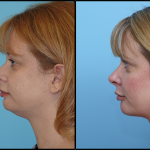Restylane Lip and Under-Eye Filler Guide
Restore Youthful Fullness to Your Lips and Eyes with Precision Filler Treatment
As we age, volume loss and thinning skin become especially noticeable in two key areas, the lips and under eyes. Fine lines, hollow tear troughs, and loss of lip definition can all contribute to a tired or aged appearance.
Fortunately, Restylane lip filler and Restylane under-eye injections offer a safe, non-surgical solution to restore youthful volume and balance.
Restylane is an FDA-approved hyaluronic acid (HA) dermal filler used to smooth wrinkles, restore lost volume, and enhance facial features. Its smooth, gel-like consistency mimics the natural HA found in your skin, making it an ideal choice for delicate areas like the lips and under eyes.
Different Restylane formulas are designed for different purposes.
Two of the most popular uses are:
Let’s take a closer look at each.
Lips often lose volume and definition with age, or they may naturally be thin. Restylane lip injections can restore shape, volume, and smooth vertical lip lines, all with natural-looking results.
Restylane lip injections are designed to enhance your natural features by adding soft, balanced volume and refining lip contours without an overfilled look.
Whether you want subtle definition or a fuller pout, Restylane offers a customizable solution to help you achieve smooth, youthful-looking lips.
Restylane lip filler treatments are quick and relatively comfortable, making them an ideal option for patients looking for immediate, low-downtime results.
With just one visit, you can enjoy noticeably smoother, more defined lips and results that last for months with proper care.
The area under the eyes is one of the first places to show signs of fatigue and age. Loss of volume in the tear troughs can create under-eye hollows, shadows, or dark circles, even if you’re well-rested.
Restylane injections under the eyes can carefully restore volume and smooth the transition between the lower eyelid and cheek, making you look more awake and refreshed.
Restylane under-eye filler is a targeted solution for those looking to refresh tired eyes and restore a more youthful, rested appearance.
By addressing volume loss and shadowing in the tear troughs, this treatment creates a smoother, brighter look, often with just one session.
Restylane’s smooth, flexible formula is ideal for the delicate under-eye area. When placed with precision by an experienced injector, the results are subtle, natural, and long-lasting.
Under-eye filler with Restylane is a precise, minimally invasive treatment performed in-office with little to no downtime.
Most patients begin to see natural-looking improvements within days, with full results revealing a well-rested, revitalized appearance over the following weeks.
You may be a candidate for Restylane lip or under-eye filler if you:
If you meet these criteria, Restylane filler may be a safe and effective option to enhance your features with subtle, natural-looking results.
The success of Restylane injections depends heavily on the skill and experience of your provider.
Lips and tear troughs are delicate areas that require advanced knowledge of facial anatomy and injection technique. Choosing a qualified provider ensures safer treatment and beautiful results.
Whether you’re looking to refresh tired eyes or define your smile, Restylane fillers can deliver natural-looking enhancements with minimal downtime. These treatments are ideal for patients who want real improvement without changing the essence of their appearance.
Ready to explore Restylane for lips or under eyes?
Schedule a consultation with a facial aesthetics expert to learn how these targeted injections can help you look as vibrant as you feel.
How long do Restylane injections typically last before needing a touch-up?
Clinical studies and real-world experience suggest that outcomes from Restylane and other hyaluronic acid (HA) fillers often last from 6 to 12 months, depending on the filler subtype, area injected, patient’s metabolism, and injection depth.
Some newer crosslinked HA fillers show durability up to 12 months or slightly beyond.
Are Restylane injections painful, and how is discomfort managed?
Mild to moderate discomfort is common during injection. Many Restylane products include lidocaine (a numbing agent) to reduce pain during administration. In fact, comparative trials show that HA fillers with lidocaine are as effective as those without, with better comfort profiles.
What are the most common side effects or adverse reactions after Restylane injections?
The most frequently reported events are mild, transient, and resolve without intervention. These include swelling (edema), bruising (ecchymosis), redness, tenderness or pain, lumps or bumps, firmness, itching, and skin discoloration.
What are the risks of more serious complications, and how common are they?
Severe complications are rare but can occur. These include vascular occlusion (leading to skin necrosis or, more rarely, vision loss), persistent nodules or granulomas, and delayed inflammatory reactions.
Systematic reviews of HA fillers classify most complications as mild and transient; serious events are uncommon but warrant careful injection technique and prompt recognition.
Can Restylane be dissolved if results are unwanted or complications occur?
Yes. The enzyme hyaluronidase can be injected to degrade HA fillers (including Restylane) if overcorrection, asymmetry, lumpiness, or vascular compromise occurs. In the literature, using hyaluronidase is a standard rescue method when complications arise.
Is Restylane safe for patients in their 60s or older?
Yes, HA fillers including Restylane are used in older adults to restore volume loss, soften lines, and improve facial contours. However, older skin may have thinner soft tissue and slower healing, which can affect swelling and recovery. In one prospective case series, different HA fillers were safely used over 12 months in patients with aging signs.
Can Restylane help improve under-eye hollows or tear troughs?
Yes — Restylane variants are often used in the under-eye / tear trough area to correct volume deficiency, smooth transitions, and reduce shadows.
How do different Restylane formulations (e.g. Defyne, Lyft) differ in performance?
Restylane is a family of HA fillers with differences in crosslinking, rheology (stiffness, elasticity), and particle size. For example, Restylane Defyne was studied in chin augmentation and shown to provide durable shape and satisfaction for up to 48 weeks with only mild-to-moderate adverse events.
Another study compared Restylane Lyft and standard Restylane for nasolabial fold correction and found equivalent efficacy and safety.
Do HA fillers like Restylane stimulate collagen or improve skin quality beyond volume?
Some studies suggest that HA fillers may have secondary effects on skin quality by hydration, mechanical support, and mild stimulation of dermal remodeling over time. However, HA itself is not a bioactive collagen stimulant in the same way as other biostimulators. The primary mechanism is volumizing and soft tissue support.
What precautions should I take before getting Restylane injections (medications, skin condition, etc.)?
Common recommendations include: avoiding blood-thinning supplements (like high-dose fish oil, vitamin E, aspirin, NSAIDs) for a few days before treatment to reduce bruising risk; stopping alcohol 24 hours prior; avoiding active skin infections or acne near the injection sites; disclosing prior filler history or filler complications; and ensuring your injector reviews your full medical history (autoimmune disease, bleeding disorders, etc.).
Can I combine Restylane with other treatments (e.g. Botox, lasers, microneedling)?
Yes, combination therapy is common in aesthetic practice. HA fillers like Restylane are often used in tandem with neuromodulators (e.g. Botox) to address dynamic wrinkles, and with skin resurfacing or laser treatments for texture.
However, timing and sequencing matter. For example, wait until filler swelling settles before laser or microneedling around the same area to minimize risk. Always follow your provider’s protocol and ensure compatibility of treatments.
How soon will I see visible results, and when is the swelling fully resolved?
Patients often see immediate improvement in contour and volume just after injection (i.e. “instant” results), though some of that is due to swelling. Over the first few days, edema and bruising will subside. In many cases, visible smoothing and settling occur within 1–2 weeks.
In clinical studies, investigators typically evaluate outcomes at 2-4 weeks as a more stable endpoint.

 Choosing the Right Facial Plastic Surgeon
Choosing the Right Facial Plastic Surgeon